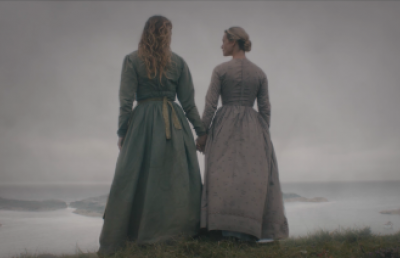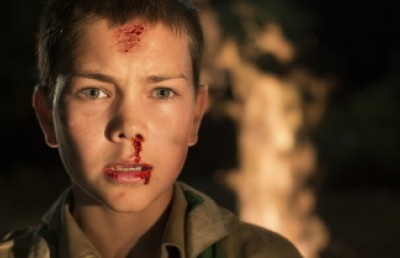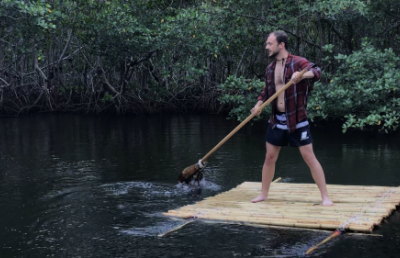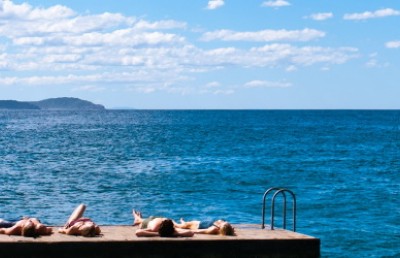Female Empowerment in the “Small World” films of Midsommar (2019, Ari Aster) and The Other Lamb (2019, Malgorzata Szumowska)
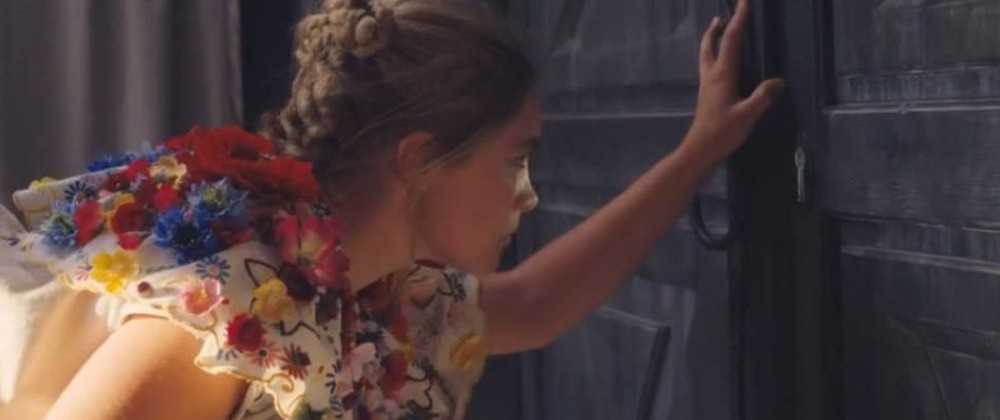
Several recent films have represented what I am calling “small world” stories, meaning films that depict isolated, insular worlds removed from normal society by distance, geographical locations or willful exclusion. One of the most striking (and excessively insular) of these films is The Lighthouse, which depicts two men living together on a remote island manning a lighthouse and slowly driving each other crazy from a combination of the isolation and their own internal demons. The Lighthouse is a film I greatly admire and will cover in a future piece. For this article I would like to focus on three other films, mostly Midsommar and The Other Lamb, while alluding to Apostle . In these three specific examples of “small world” films the small world is led by powerful religious, cult or cult like figures who define the world according to their own stringent moral, religious or pagan codes. Midsommar (Ari Aster, 2019), The Other Lamb (Malgorzata Szumowska, 2019) and Apostle (Gareth Evans, 2019) play their stories out –as do many small world films— in highly secluded, rural, and insular society’s.
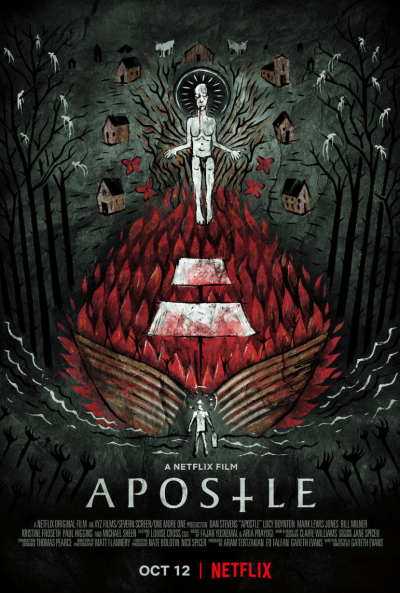
In Midsommar and Apostle the ruling order require humans that are outside their social order to sacrifice in order to maintain their livelihood. In both these films the human bodies that are sacrificed directly nourish the earth. In Apostle (Gareth Evans, 2018) the titular character is seemingly human but with special powers who has a direct supernatural link to nature, and the human sacrifices are needed to nourish the ‘apostle’ who exists in greenhouse adorned with medieval torture devices where human sacrifices are literally mashed up and fed to the “apostle”. Apostle is a far more conventionally structured horror film, with intense violence and gore, in contrast to the more counter-intuitive style of Midsommar and The Other Lamb. But like Midsommar the insular society is penetrated by an outsider. In Apostle it is a drifter named Thomas Richardson (Dan Stevens) who comes looking for his sister Jennifer (Elen Rhys) who has been kidnapped by the community as a potential ransom to help the community’s dire situation. The community is led by a prophet name Malcolm (Michael Sheen), but laying in the wings to usurp Malcolm is the far more sinister and violent Quinn (Mark Lewis Jones). In contrast to Midsommar’s sun-drenched visuals, Apostle, which is set in 1905, has the look and feel of a medieval town, with a muddy, dark visual palette.
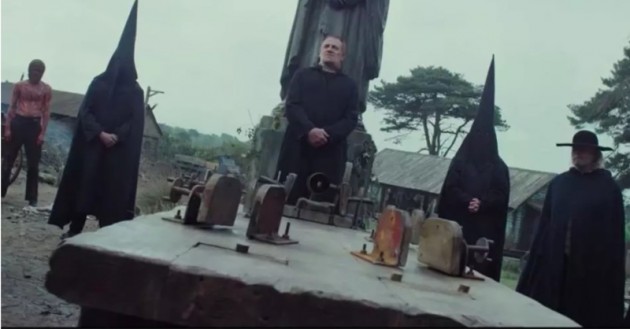
Medieval styled mise en scene in 1905
Compared to Aster’s first film Heriditary, Midsommar is far more focused of a film, singular in its attempt to subvert the normal visual approach to horror, not that unlike Kubrick and The Shining, a film which I think Aster pays homage to in the opening car trip to the community. On the surface Midsommar is many things: a modern day Wicker Man, a folk horror, adult fairy tale, a story of female empowerment, a story about the importance of letting one’s emotions flow out and beyond the surface, not being bottled up and contained, and perhaps a few more things. Whereas horror is usually filled with dark shadows and black spaces, things hidden in dark spaces, in shadows, in the recesses of the mind, Aster films his horror in the blinding light of a long Swedish summer solstice (actually filmed in Hungary, but in hot summer weather). Like Wicker Man, you know that there will be outsiders that are lured to an isolated community for the sake of fulfilling a ritual sacrifice. The only question becomes, when exactly, how, and to whom. Which is what happens to four friends, or three male, twenty-something friends and one of their girlfriends, Dani (Florence Pugh), who is seeing Christian (Jack Reynor), a PhD student along with fellow Phd anthropology students Josh (William Jackson Harper) and Pelle (Vilhelm Blomgren) and Christian’s best friend Mark (Will Poulter). Pelle has invited his North American friends to his North European ancestral home to experience a summer solstice ritual that comes only every 90 years.
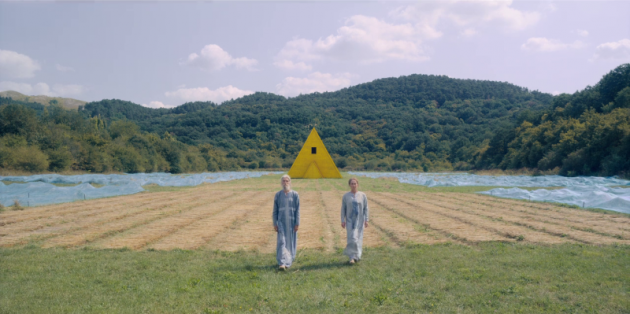
Two elders on the walk to self-sacrifice
Given their mutual love and academic interest in all things folkloric, Pelle sees it as a great opportunity to bond, do some research, and maybe further their relationship. As students of culture and anthropology he thinks this will be beneficial and enriching. But a dizzying visual gesture early on suggests that things may not be as they appear. In the car ride from the airport to the rural area, Hälsingland, the drone camera cranes down to the car but then pivots 180 degrees away and upside down, to view the road in an alien upside down position from the back of the car, before it cuts to the front but in the same upside down position. As it drones forward the wide angle lens camera seems to be moving along, if not trapped, in a tree-lined tunnel. The impression is very estranging and it foreshadows a world whose values are upside down from that of the characters, and us.
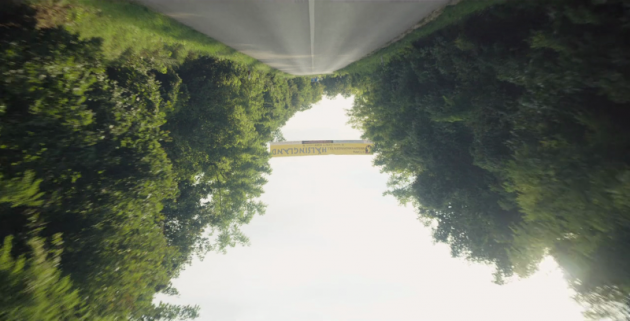
A world turned upside down
The emotional center of the film for the audience is Dani, a character made frail by her family situation, marked by a bipolar, suicidal sister who seems an emotional burden to Dani. In the slow and eerily portentous opening Dani’s unbalanced sister leaves her an ominous text message, which alarms her. Dani’s boyfriend of nearly four years, Christian, who she relies on for emotional support, too much so according to Christian’s friends, thinks the sister is just crying for attention. But in the next harrowing scene, revealed by shots that cut from firemen examining the tubing tied to a car’s exhaust pipe to a camera that slithers and slow dissolves to follow the firemen as they trace the aftermath of the patricide and suicide of Dani’s sister. A short time after this tragedy Dani learns of a trip to Sweden that Christian was planning with his friends, unbeknownst to her. Guilt rather than empathy forces Christian to extend the invitation to Dani (we sense from Christian’s behaviour that if the tragedy had not befallen Dani he would have ended their relationship). Christian’s less than honorable personality is revealed not only through his indifferent conduct with Dani, but later on in the way he upsets fellow grad student and friend Josh by deciding during the retreat to move in on Josh’s research area by planning his Phd research on a similar folkloric subject. If you know how protective and sensitive PhD students can be about their area of research, you can imagine how upsets this makes Josh.
The trip to Sweden is meant as a release for the grieving Dani. It ends up being that and much more, as the primal, grass-roots based life-style of the Hälsingland community taps into Dani’s need for a cathartic release of her trauma. And is encouraged by the subtly matriarchal structure of the pagan community –which stands in stark contrast to the authoritative, staunchly patriarchal nature of the ruling powers in The Other Lamb and Apostle.
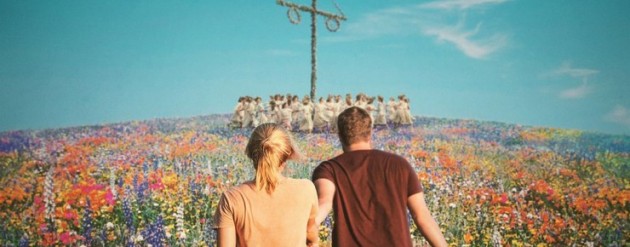
Dani and Christian
During the trip we come to realize that Christian is not as fully committed to Dani as she is to him. And their relationship is one of an uneven co-dependency. It is during their stay at the retreat that Dani grows in emotional strength, a slow progression that is aligned with her realization of the matriarchal strength in the community. When she wins the maypole dance contest and is crowned May Queen, she is placed by the community’s carefully planned conspiracy in a position of authority over Christian. Christian is ‘chosen’ by one of the community’s women to impregnate her, an act witnessed by Dani and which only strengthens her resolve to break free from Christian and fully adopt the Hårga way of life. After his ‘seed’ has been planted, Christian is symbolically castrated —he is paralyzed, has his vocal cords cut and is placed inside the body of a huge bear. In the film’s climax May Queen Dani is placed in the position of choosing the ninth and last sacrifice to complete the ritualistic offering. Christian is now cowering in fear in front of her, looking foolish inside the body of a bear, powerless to sway her decision to choose between either him or another chosen community member as the last, ninth sacrificial victim (the previous eight being the two elders who jump to their deaths in the film’s most stunning scene, Josh and Mark, a young British couple who are friends of Pelle, two other volunteers from the community). We don’t see Dani make the choice but learn of it when we see Christian carried into the ‘yellow’ temple, where straw effigies of the eight other sacrifices are laid out. The impact of the decision on her state of mind is only revealed to us in the final shot of the film, a close-up of Dani’s smiling face.
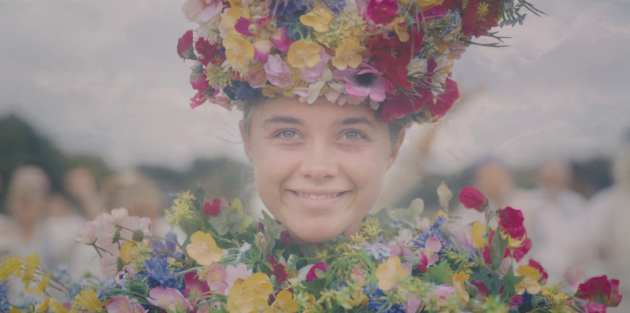
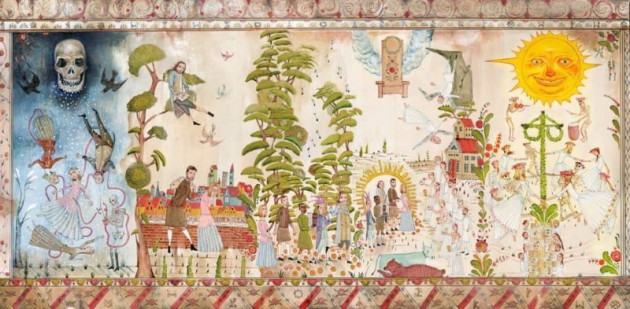
Detailed art direction which foreshadows story in detail
Aster’s control of every aspect of the mise en scene is impressive here. This comes largely from the fact that the film was shot on a dressed set, in the tradition of the western towns that were built on studio lots. Or in the case of the spaghetti western, often dressed on location in Almeria Spain. Midsommar was filmed on a large field Aster discovered in Hungary that was wild, savage and had to be trimmed and domesticated to accommodate the building of several buildings, some as high as three stories. The community itself, the temple, the barn, the sleeping quarters, the administration building, the long communal eating tables, everything was built from scratch to the specific requirements of Aster and the art and set designers. One of the great pleasures in the film is attending to the great detail in every location. The drawings on walls that recount the community’s belief system that foretells the story. The wall-to-wall paintings in the high ceiling barn where the young people (everyone under 32) sleep. The grotesque human victim art pieces that form the inside of the temple which will be burned to the ground in the climax. Not to forget the intricate dresses that are individualized for every character seen on screen. It is a very impressive design that completely sells the idea that this is a fully self-functioning rural community that lives and dies by its own pagan-inspired, cult-like rules.
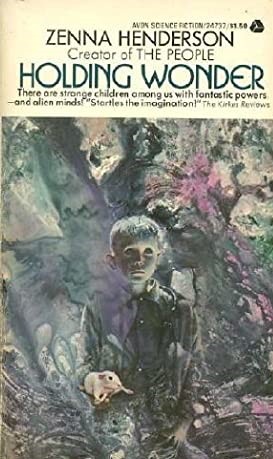
The depiction of the insular, rural community reminded me of a fantasy/SF writer from the 1960s, 1970s I read, Zenna Henderson (1917-1983), whose work is now regarded as being proto-feminist for the way her community put forth a gender egalitarianism. In her prime she wrote a series of novels about an alien race forced to leave its dying planet and settling into a remote rural area where they construct a community and live in quiet isolation from the rest of earthlings. They were called “The People”, and the depiction of the hermetically sealed community Aster erects in Midsommar reminded me of the worlds from Henderson’s stories.
For all the impressive lighting, shot compositions and moving camera choreography we get in the film from Aster and his DP Pawel Pogorzelski, I was less impressed with the CGI trickery of quivering trees and buildings to emulate the drugged out point of view scenes. Compared to the upside down drone camera and surreal blending of tone and color (especially for the suicide deaths), the CGI effects felt too gimmicky and less organic than the way other films have depicted trippy, psychedelic experiences (Climax, Mandy, Bliss, The Color Out of Space, to name just a few recent films ones that used more organic formal devices to achieve the effect, namely saturating color, montage effects, camera movement, music and sound, etc.).
The film is of course indebted to Robin Hardy’s seminal folklore horror The Wicker Man, but there is much to separate the two films. For starters, there is a lot of dancing in TWM which forms a general part of the atmosphere, whereas in Midsommar dancing is restricted to a single scene near the end, which is treated with great care (although on a related note, there have been many horror films lately that have used dancing to great thematic value, namely Suspiria, 2018, Climax, 2018, Us, 2019, Anna and the Apocalpyse, 2017). All the young woman of the community must dance around the maypole for however long it takes to elect the winner, who will be crowned May Day Queen. The last woman dancing. It is an endurance test but also seems planned to make Dani the winner, as some women knock into each other, eliminating themselves. The camera choreography is as important in this scene as the women, as it alternates from the position of the observer, outside the circle, to the inside position of the pole.
The violence in Midsommar, when it starts to surface, is made more horrifying because of the sense of lightness, symmetry, natural beauty, and ethereal confluence of light, color and tone that permeates most scenes. Nowhere more strikingly than the moment where the friends come to realize what they are up against when they witness two elders of the community throw themselves off a cliff down toward a strategically placed large boulder on the ground. The two hundred are so foot drop is designed so the victim lands face first onto the large, flat stone boulder. Everything of formal matters seeps together in these shots. The white dresses of the community members, which contrast the slightly off-white, grey-blue dresses of the two victims, the white sand, the white ash side of the mountain, the white sky, and the over-exposed lighting, gives the scene a sense of formal perfection which forms a moral relief to the sight of two elderly people willingly throwing themselves to their gory death —and the rare splashes of blood red.
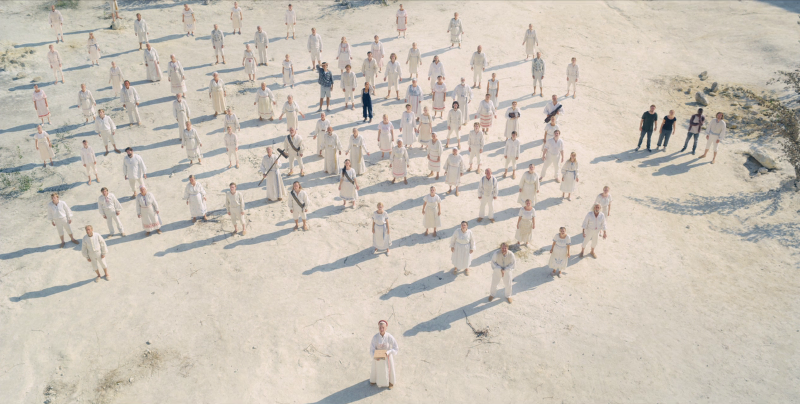
Mise en uniformity in Midsommar
Why these two elders? An earlier moment provides an answer, where Pelle explains that the life cycle of this community ends at 72, as the community prefers a person to die before they become too old and wither away (in an exchange which brings some social commentary, when the shocked outsiders try to reason the horror of what they just saw, one of them wonders whether this ritual is any worse than placing elders into old age residences). After Pelle’s explanation of their life stages, the long, special dinner in honor of these two elders the precipitates the Fall, feels especially portentous.
In the end, the only outsider who comes out alive is Dani, who Pelle has obvious amorous designs on. As she succumbs to the sense of community and uses this to also empower her own agency, as the May Day Queen, with her newly anointed power, she chooses Christian as the ninth and last sacrifice, over another community member chosen by chance. It is a decision we see coming, and partly condone, given Christian’s selfish behavior. The final image of the film is saved for Dani. A close-up of her face slowly giving way to a smile. It recalls, in a strange way, the finale image of the 1977 Suspiria, which ends on the look of relief and joy on the face of Suzy Bannion as she exits the crumbling house of witches.
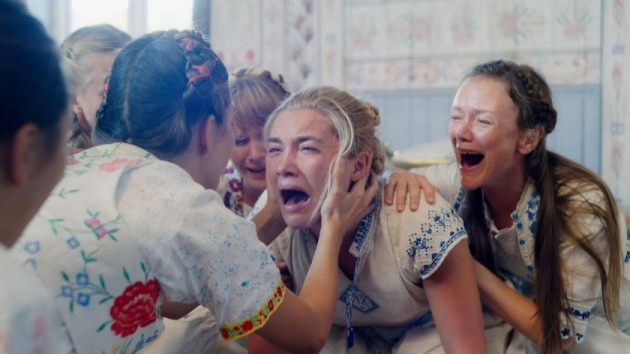
The women empathize with Dani’s grief
It is difficult to pronounce Midsommar as feminist, as some have done. Dani ends up freed from her co-dependency on Christian, but at what cost? A feminist perspective appears if you consider other aspects of representation, like the fact that Aster freely puts male frontal nudity on display, rather than female frontal nudity. In the scene where Christian is hand-picked (actually, ‘kicked’ by the woman dancing past him as to stake her claim on him, in perhaps a funny twist on that adage) to provide a ‘non-incestuous’ progeny (one man with a horribly deformed face is kept around on display as if a reminder of what can happen with too much in-breeding, in perhaps the film’s only moment of bad taste). Christian is clearly used and objectified in this scene, as he is forced to perform in the middle of a half circle of nude women who are not sexualized but placed in a position of power. The way an older nude woman goes behind Christian and helps him thrust his loins into the women bears a sense of humiliation and mockery, not unlike the scene in the Suspiria remake where the witches emasculate a pair of detectives by stripping them and making fun of their penises. To quote Aster, it is a moment of ‘earned catharsis’, an element vital to horror, earned for the character of Dani, but not necessarily for the viewers, who are left in an emotional lurch. An unsettled place to be. But the kind of place only great horror directors manage to place their audiences in.
The Other Lamb (2019, Malgorzata Szumowska) makes an interesting companion piece to Midsommar largely because it deals with similar gender themes, within a cult ‘small world’ context but is directed and written (Catherine S. McMullen) by women. Although both films rely greatly on visual language and shot on beautiful locations aesthetic, and the stories are quite different, the dynamic shift of power from male to female is the same across both films. In Midsommar the subservient to the man (emotionally) Dani gets the upper hand at the end, leading to the death of the male character Christian (actually all the outsider male characters die), and there is a rebirth of the lead female character. In The Other Lamb the scale is smaller, with a single man who calls himself the ‘Shepherd’ (Michiel Huisman) and lords over his human flock of (mainly) beautiful girls and women, who are ostensibly mothers and daughters, in a perverse distortion of Biblical rules and edicts. The all-female community of about twenty and the Shepherd, live in a makeshift enclave in the middle of a forest. As we later learn, the community is nomadic, moving on to new ‘land’ when they are found out by nearby authorities. The value (to him) of the women are purely predicated on age and his whims on notions of ‘Eden’, ‘Grace’, and ‘Purity’. So that a woman who has passed her sell through date is either cast out of his flock (like Sarah, played by Denise Gough, who lives nearby in a cave) or kept within the flock but figuratively shoved to the end of the line. The Shepherd calls these people who are no longer worthy of his grace as ‘broken’. Life inside this insular community revolves entirely around the whims and beliefs of the Shepherd. The female species is valued only for what they can give to the Shepherd. It is perverse distortion of any and all gains made by feminism since gender equity became even a thought.
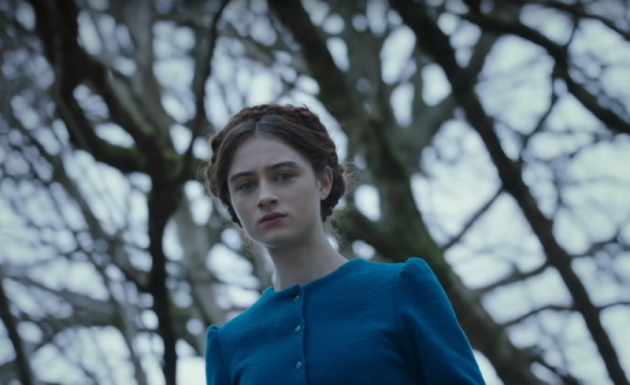
Selah looking determined
The mothers wear red frocks while the younger women (who in some cases are daughters) wear blue frocks. The one female who is marked by the camera as the one who can challenge the Shepherd’s authority is Selah (Raffey Cassidy) who is just about to become a woman (have her first period). In a dramatic sense there is little suspense on whether the Shepherd will get his comeuppance. It would be hard to imagine a film made in 2019 in the Americas by women (or by anyone for that matter) that would put women under such duress and emotional and physical oppression that WOULD NOT end with a cathartic shift in power (Unless made by women who are fully devoted masochists!). The pudding is more in the details. For example, there are many questions left unanswered that make up the drama and the slow realization (by the flock) that their Shepherd is not their protector. Selah begins to visit the discarded Sarah and finds out that she was once a favorite wife who cast out as being ‘broken’, which ostensibly means ‘old’. Selah learns about the past from Sarah, who has attained the status of wise woman, even if she is this side of 40. Selah learns about her mother, who died giving birth to her. At first depicted as threatening or feral, Sarah ends up being a heroine when she decides near the end of the film to save a male baby left for dead after the mother dies in birth, and leaves the “flock” to start life anew. She tells Selah that she knew her mother and that her death was not an accident, and that she did not die at birth, as the Shepherd says, but through negligence. After she gave birth she contracted an infection, which could have easily been treated if Shepherd would have brought her to a hospital, but instead he chose to let her slowly die from the infection, saying it was God’s Will.
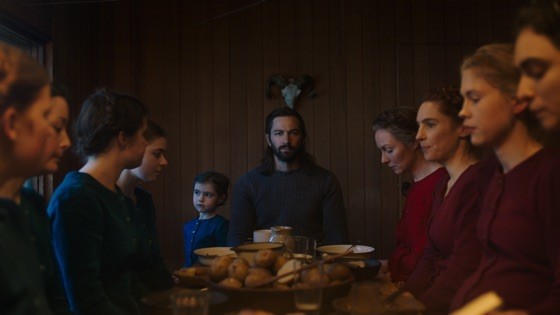
The Shepherd in a Biblical looking supper
What The Other Lamb does differently from Midsommar is that it uses dream and fantasy imagery much more, often placing us in the mind of Selah, who has visions of members of the flock floating under water (perhaps an homage to The Piano, a feminist film where a woman (Holly Hunter) grows and separates herself from an oppressive man), or visions of a slaughtered lamb, and one striking vision of a Dionysian destruction of the Shepherd, which culminates in Selah ramming a rock onto his head (another parallel to Midsommar, in the scene where the second elder who falls off the cliff miraculously is still alive, until three members of the community take turns smashing his head in with a wooden mallet). Another of Selah’s visions see her in a staring context with a ram, who no doubt serves as a surrogate for the Shepherd.
The most dramatically and thematically interesting vision she has is seeing her double dressed in regular civilian clothes driving in a car with her family on a nearby road, as she and the flock walk alongside the road. In her vision (or is it a flashforward?) the ‘two’ Selah’s make eye contact and are both shocked by the sight of their living double.
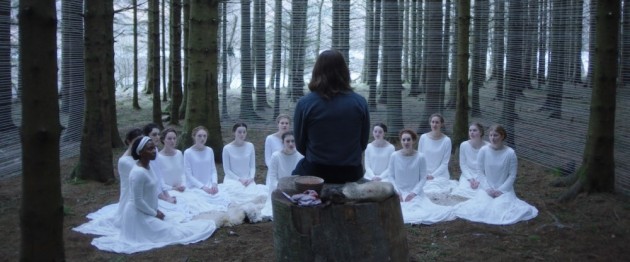
The outside temple
As part of their small living village, the Shepherd has constructed an open air temple of sorts in a section in the woods cordoned off by tightly wound cotton. It is an arresting image, where we see them praying, partake in rituals, like a scene where the whole flock share primal cries in unison (a scene which has it echo in Midsommar). After a police visit where an officer speaks to Shepherd in long shot (we don’t hear the conversation but get the gist of it) the Shepherd tells his flock that they must leave in search of a new home, otherwise they will be taken away from him by the authorities. The thought of them being forced to separate causes them to cry, a gesture which shows just how profound is the Shepherd’s hold on them, and the Shepherd himself feints (is it a staged collapse?). In a surprising act of solidarity (and for the viewers who hope the women would take this as a chance to leave or kill the Shepherd, morally depressing) the women hoist him on their shoulders and begin to carry him while joyously singing his praises.
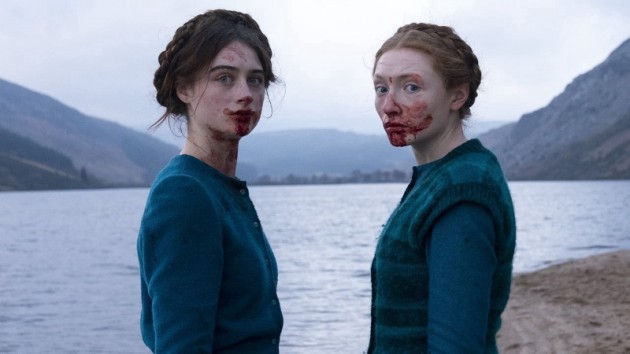
A vision
The journey to a new ‘Eden’ answers some questions about the Shepherd’s identity and behavior but leaves one unanswered: how is he able to move from mother to daughter while remaining young and strong? Is he made in the image of the women, who imagine him always young, handsome and strong?
The journey also functions as a growing realization for the flock. Three acts signal to the flock that action must be taken against him. The first is when a pregnant member dies in agony after a painful premature delivery. The Shepherd leaves the women’s body behind, as well as the child, which happens to be a son. Which explains why there aren’t any men in the flock other than him. He must be the solitary ram. We assume any sons born have been left to die, a horrible thought. After many days on the journey the women are tired. When one of girls tells the Shepherd that she thinks sees a house in the distance, the Shepherd takes this gesture as an act of insolence for daring to doubt his leadership, and physically attacks the poor girl in front of all the others. The final straw is when the daughters awake to find all their mothers missing and discover the Shepherd has drowned all of the mothers in a perversion of baptism. In the final scene two police officers come across the horrible scene of all the corpses swept ashore and the Shepherd’s mutilated corpse hanging on a branch. The last image symbolizes the end of the Shepherd’s reign when we see a close-up of Selah holding a slaughtered lamb, the titular ‘other’ lamb, in her arms.
The film can seen as a grand scale metaphor for the Me#too movement, with women standing up to their oppressors, but also on a smaller scale, as Selah’s coming of age, her development into womanhood the trigger for her rebellion against the Shepherd. As such the film lacks any subtlety from a thematic standpoint but can be appreciated from the formal and stylistic sense. Director Szumowska, rightly or not, deprives the audience the ‘cathartic’ pleasure of seeing the Shepherd murdered by his flock, an aesthetic or narrative gesture which stands in contrast to Midsommar’s unsettling catharsis. Which goes to show that in a good horror film, there is more than one way to skin an ugly patriarch.



